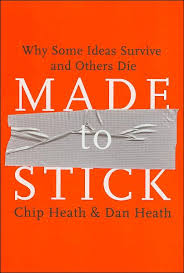Made to Stick: Why Some Ideas Survive and Others Die

– By Chip Heath and Dan Heath
Why is it that some ideas stick and others don’t? In Made to Stick, brothers Chip and Dan Heath dissect this issue and, based on their research, they outline a set of six principles to help us come up with ideas, presentations, communication, that can be memorable and effective. In other words – sticky. In today’s world, we are busier, possibly inundated with hundreds of messages, and to cope with all this clutter, we tend to ignore most of it. In today’s cluttered world, it has become even more important for marketers, salesmen, advertising people and others to come out with ideas that stick. The good news, according to Chip and Dan Heath, is that all of us can learn the art of coming out with powerful, stickier ideas. However there is one villain ‘that consistently confounds our ability to create ideas using these principles. It’s called the Curse of Knowledge.’ The person sharing the idea has so much of knowledge about a subject that it becomes difficult for him/her to effectively share that knowledge with others – he/she is unable to see things from the listeners’ point of view – and is thus unable to make that idea memorable.
Made to Stick examines – in detail – the six principles that can make an idea truly memorable and sticky:
- SIMPLE. The key to this principle is to find the core of the idea. Simplicity implies distilling the idea to its most essential and making it as profound as possible. One of the examples that Chip and Dan Heath use concerns the Army – the Army spends a huge amount of time and energy to plan a battle but finds that these plans turn to dust in real combat. The Army, therefore, now uses a ‘Commander Intent’ rather than a plan for better effectiveness.
- UNEXPECTED. You can’t demand attention, you have to attract it. We humans think in patterns and the key is to break these patterns.
An example from the book is about the announcement made by a flight attendant from Southwest Airlines – ‘If I could have your attention for a few moments, we sure would love to point out these safety features. If you haven’t been in an automobile since 1965, the proper way to fasten your seat belt is to slide the flat end of the buckle. To unfasten, lift up the buckle and it will release. And as the song goes, there might be fifty ways to leave your lover, but there are only six ways to leave this aircraft: two forward exit doors, two over-wing removable window exits, and two aft exit doors. The location of each exit is clearly marked with signs overhead, as well as red and white disco lights along the floor of the aisle. Made ya look!’
In using the unexpected, avoid the gimmicky. However, violate people’s expectations. Be counter-intuitive.
- CONCRETE. Mission statements, strategies, visions – they tend to be so ambiguous and boring that they become totally ineffective. Concreteness comes when we explain our ideas in terms of human actions, in terms of sensory information. Aesop’s Fables have endured for 2,500 years because they convey concrete images. As have proverbs.
- CREDIBLE. People believe ideas when they come from a credible source – our parents, experts, authority, experience, even faith. However, what does one do when these sources are not available? There are various ways to do this:
- Use an anti-authority. Pam Laffin, a non-celebrity, was used in a series of antismoking campaigns. She was a smoker.
- Use vivid details.
- Use statistics.
- Use the Sinatra Test. The Sinatra test states that if you can provide one strong and credible example of having done something, it could boost your credibility in doing similar things.
- Testable credentials – Reagan’s ‘Are you better off now than you were four years ago?’
- EMOTIONAL. The emotions is Made to Stick is not really about pushing people’s emotional buttons; rather the goal of making your idea emotional is to get them to care about the idea. People act if they care. In a study, researchers tested two letters to get people to donate – the first was a rational, stats based letter highlighting the problems that children of Africa were facing; the second version gave information about a specific child in Mali. No marks for guessing which letter got the better response.
- STORIES. An idea will stick if it is told as a story. Stories are powerful because they provide context missing from abstract prose. Stories hep in ‘burning’ ideas into the mind. One should always be on the lookout for stories because many stories are discovered rather than made up. An example in the book is the story of Jared Fogle that Subway used in their campaign in the 1990s. Jared lost 245 pounds by eating Subway subs for lunch and dinner.
The six principles have been given the acronym of SUCCESs by Chip and Dan Heath.
Made to Stick is an entertaining book; more than that it does provide a simple set of guidelines for creating ideas that stick. Of course, many of us are likely to say that the six principles that they have highlighted are commonsensical. Yes, they are but very few of us use them in our work life. We could do a lot better by following these principles.
Rating: A+
